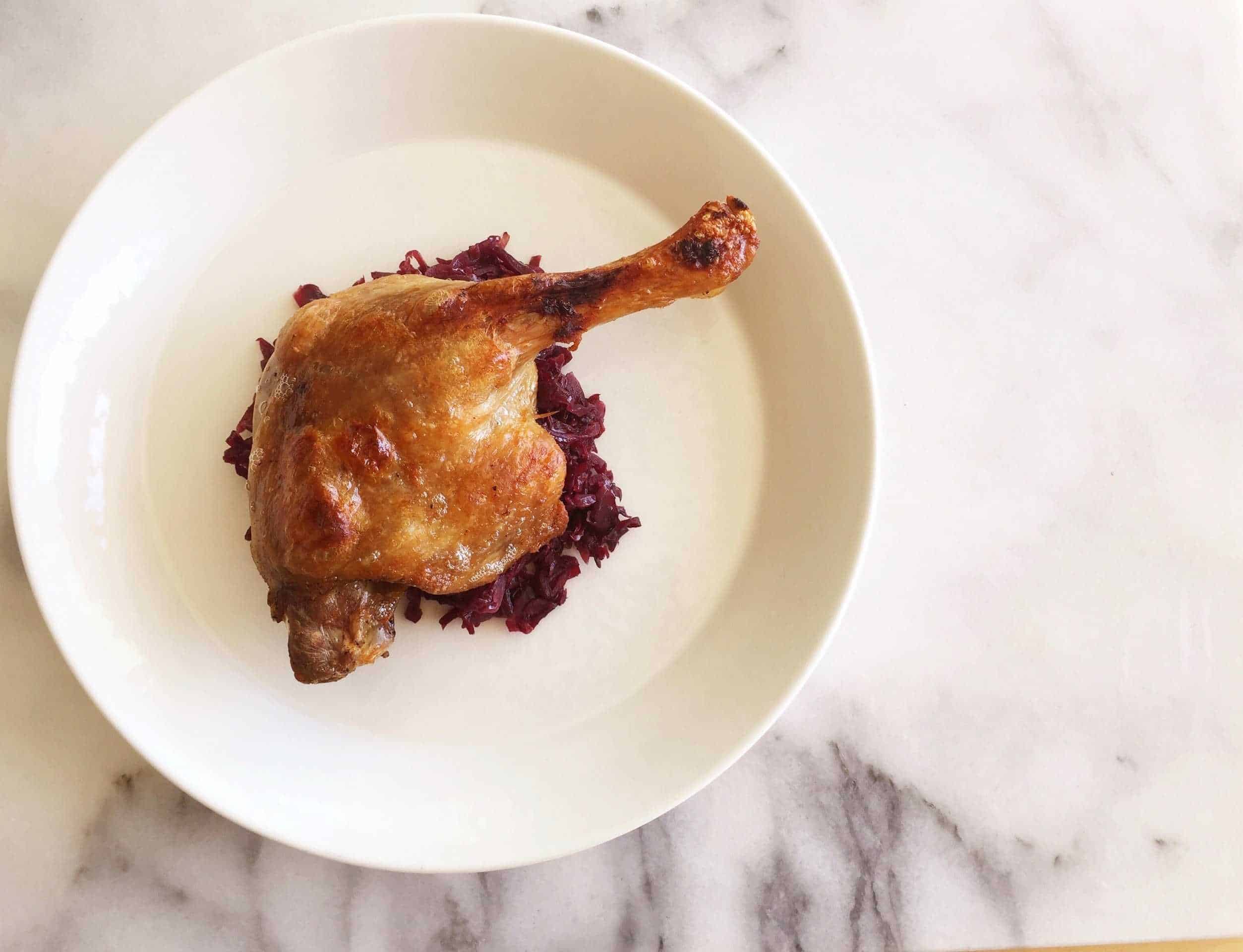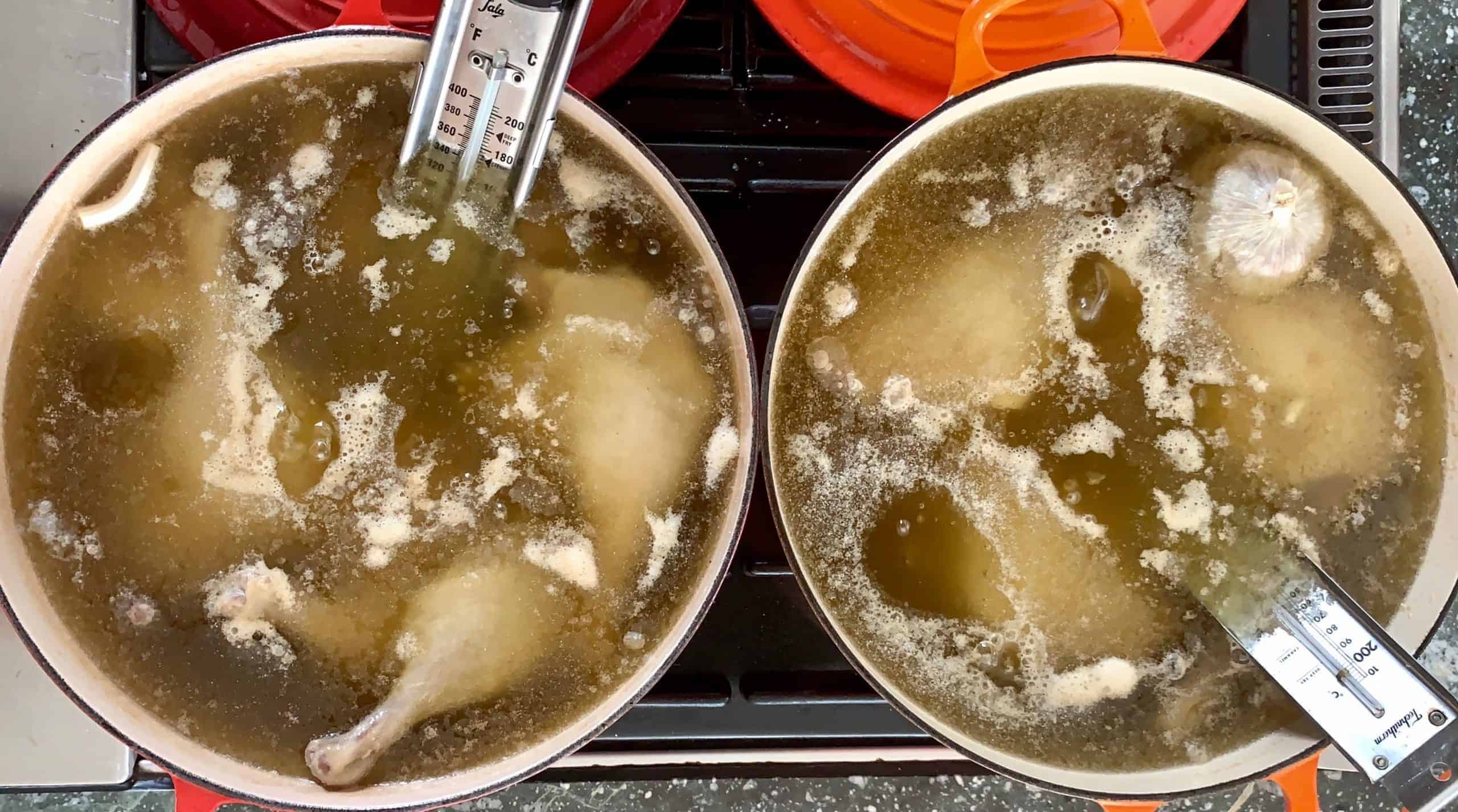It’s Duck Confit All The Way, Not a Turkey in Sight.

No Turkey at Our Table . . . No Ham in Our House . . .
This is how we celebrate the festive season at my place – with duck confit.
Being Jewish, we don’t celebrate Christmas but why should we miss out on all the delicious traditional food of the season? So in our nod to the festive season, we sometimes do like to indulge in roast turkey with all the trimmings, steamed plum pudding with brandy sauce and custard, the best fruit cake we can get our hands on and of course our fabulous Monday Morning Cooking Club chocolate almond tree.
To my taste, duck trumps turkey any time, and confit duck kills it. I’ve always been fascinated with confit, ever since learning about it from one of the best teachers – Damien Pignolet. He taught us, decades ago, how to make confit rabbit. And from Paula Wolfert via Stephanie Alexander, I learnt to confit duck.
It is a time consuming and messy process, I won’t lie. It takes two days. Yes, two days. But the result is so spectacular that I think it is worth the effort once every so often. The good thing is you can keep the fat in the freezer from year to year and that way you can keep your rendering to a minimum. It’s also a great thing to make in a large quantity and then just store in twos or fours until you need in the fridge. The flavour is like nothing else!
If you want to render duck fat, ask your butcher to give you a few bags of raw duck fat. Simply place it in a large pot and cook slowly on a low heat until it is clear and golden. Strain through muslin (I use Chux wipes) and store in the fridge in a sterilized container until needed. Will keep in the freezer for years and can be re-used for confit again and again as long as sterilization processes are always followed. You can also buy duck or goose fat in cans but it is very expensive. If you have a nice poultry supplier you can ask if they will render the duck fat for you. And with all that duck fat around, remember that potatoes are transformed into legendary golden crunchy flavoursome morsels when roasted in duck fat.

Duck Confit, A Festive Season Fave.
Ingredients
- 8 duck marlylands (skin on, backbone removed)
- 1/4 cup sea salt (heaped)
- 4 French eschallots washed and roughly chopped
- 1/4 bunch Continental Parsley chopped
- 1 tablespoon black peppercorns roughly crushed
- 2 bayleaf crumbled
- 2 cloves garlic chopped
- 2 sprigs thyme roughly chopped
- 2 litres rendered duck fat (from approx 2 kg duck fat)
- 1 whole garlic halved
Instructions
- Mix together the salt, eschallots, parsley, peppercorns, bayleaf, garlic cloves and thyme. Toss each duck piece in the mixture and place in a glass or ceramic dish. Tip any remaining mixture over the top and cover with plastic wrap. Put in the fridge for 24 hours.
- Remove from the fridge and quickly rinse off each duck piece under cold water. Pat dry with paper towels.
- Put the duck fat into a large ceramic or other wide saucepan (I use a Le Creuset, 4 litres). Heat the fat until it is JUST liquid (but not too hot) and slip in the duck pieces and the halved head of garlic. Heat this very slowly until it reaches 90C (190F) (I use my candy thermometer). This can take around 1 hour. Once it is at that temperature, cook for another hour or so and then test the thickest part for tenderness. You want it to be really soft,almost fork tender. If done, allow to cool for about one hour.
- With a ladle, remove all the fat to a clean saucepan, leaving behind any meat juices. Bring this to boil and simmer for 5 minutes until any spluttering stops and it is clear and golden.
- If you are planning to eat the confit within a week, allow the fat to cool a little and simply put the duck legs in a container and cover with the fat. Store in the fridge until needed.
- if you would like to keep it for longer (and impart a better flavour), then you will need to follow this careful sterilization process. I use a large plastic Tupperware/Decor tub and first put it in the dishwasher to clean thoroughly. Sprinkle 1/4 teaspoon of salt in the bottom and pour in 5 cm (2 inches) fat. Place in the fridge and allow to set until solid. Remove from the fridge and carefully place the duck pieces on top, avoiding the sides. Pour the remaining fat on top until the pieces are covered by at least 2 cm (1 inch) of fat. Make sure there are no air pockets. Allow to cool and then refrigerate. Once this is hard, pour another layer of fat (2 cm/1 inch) of fat on the top. Cover with baking paper, seal with the lid and refrigerate until needed.
- Remove from the fridge about 2 hours before you are ready to eat it. When the fat has softened, using gloved hands, remove each piece of duck and scrape off the fat without tearing the skin. Place each piece on an oven rack. When ready to eat, preheat the oven to 200 C (400F). Place the rack over a baking tray in the oven and cook the duck until really golden and sizzling, around 10 minutes.
- Serve with slow cooked red cabbage and potatoes cooked in duck fat.
Did you love this post? Want to keep up with the Monday Morning Cooking Club girls? Click here!







